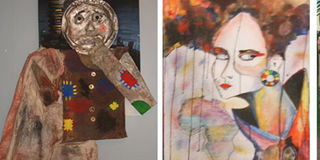Students learn from the master

From left: Bagman, by an anonymous student and Beauty of a Woman, by Paul Muigai. Photo/FRANK WHALLEY
What you need to know:
- The museum held art classes every Saturday morning and every object was up for grabs.
- I spent hours being taught how to draw the stuffed animals, the sculptures, the mummies, the masks.
- I remember in the Japanese room there was a life-size snake, made of blackened iron with every scale a separate, articulated piece.
When I was a small boy, around seven, my mother decided all that playing out during the long school holidays was not doing me much good.
So away went the bow and arrows and the cowboy gun and instead I was taken by the hand and dragged around Manchester’s finest art galleries and the university museum.
Tears gave way to fascination.
In the room devoted to the Victorians, there were big pictures of classic battles with glinting swords and armour, a gigantic view of a chariot race and brightly coloured paintings of ladies not wearing much at all (at once puzzling and wonderful, but I pretended not to have noticed.)
Impressionists had bathing scenes, boring pictures of fruit, and the seaside — and in another hall there was a magnificent painting by George Stubbs of two Indians with a tame cheetah. They had exotic turbans and flowing robes and were about to unleash it at a stag. I had a home-knitted tank top and the family dog; a corgi. No contest really.
The university museum proved to be a winner too.
There were halls full of stuffed animals — lions, tigers, a polar bear, and the skeleton of a real whale hung from the ceiling.
In the Egyptian galleries there were the mummies… every 1950s child’s equivalent of the Daleks — hide behind your own mummy and go closer if you dare.
And there too were the ethnographic galleries; case after case of dangerous weapons, shrunken heads, fetish statues and masks.
The whole thing left me with a lifelong interest in painting, sculpture and tribal art. Wildlife too, I suppose. Perhaps the seeds of life in Africa were sown in those rainy days in post-war Cottonopolis.
When I hit my teens more opportunities awaited.
FREE AND MARVELLOUS
The museum held art classes every Saturday morning and every object was up for grabs.
I spent hours being taught how to draw the stuffed animals, the sculptures, the mummies, the masks.
I remember in the Japanese room there was a life-size snake, made of blackened iron with every scale a separate, articulated piece. I still don’t know how they did it.
It was all free and it was marvellous.
A joy then to learn that the National Museums of Kenya has a similar art class, materials provided and visiting artists of the calibre of Leonard Kateete on hand to offer inspiration and advice.
The idea, we are told by a poster that spells Mr Kateete’s name two different ways within 12 lines, was to help students to think outside the box, solve problems and explore their abilities for creative expression.
The students, all in their late teens, are showing 17 pictures in the ground floor gallery. All the works are sturdily framed, hung at eye level and for the most part informatively labelled.
In this sort of show, given a reasonable level of visual literacy, the fact that it exists at all is arguably more important than the finer points of quality. Good to see then, almost as a bonus, that there is sufficient talent on display to warrant places at an art school and some hope for the next generation.
There was excellence in fact from one student who had built a wall sculpture of a bagman, sack on his shoulder and a face made from an old plate. I would love to give you his name but the label was missing. (It is the NMK, after all.)
Other missing labels meant I could not identify the student who made the intricate ballpoint drawing of a cyber cop, nor the Expressionist who painted a shisha smoker, with her piggy nose.
There was better luck with a bas-relief portrait called Usher. Made of leather, beads and pieces of cloth it was welcoming us towards new opportunities, said the statement by its imaginative maker, Charles Aura.
I liked too the frantic pencil and ink drawing of modern music’s effect on culture by Brian Arome, and the mosaic collage about drought, by John Njuguna.
SNEAKY EYES
One of the highlights was an assured watercolour drawing by Paul Muigai called Beauty of a Woman. It reminded me of the psychedelic album sleeves of the 70s and had sneaky eyes.
Take it all for what it is: A worthwhile and enjoyable exhibition by students keen to learn their craft.
On your way out, spare a minute to look in the glass case opposite the help desk. It contains two tortoises; both dead, presumably stuffed, or at least moving extremely slowly as is their wont.
One is the rare Pancake Tortoise — which is, satisfyingly, as flat as its name suggests. Set aside fears that a curator trod on it then renamed it as a joke… it turns out they live in eastern and south-eastern Kenya and a bit of Tanzania, munching greens in shallow crevices.
All museums should have curiosities to maintain interest. The Pancake Tortoise fits that bill superbly. And try as I might, I don’t remember them having one of those in Manchester.
This article first appeared in the East African




